


A newsletter for modern marketers.

TRUSTED BY THE WORLD'S SMARTEST MARKETERS
Free ad performance benchmarks every week.

Live webinars and strategy sessions with industry leaders.
Watch all previous episodes on our YouTube channel.
Insider strategies from the smartest brands in ecommerce.
SEE LATEST POSTS:

Introducing Incrementality by Northbeam: Automated Lift Testing You Can Trust

We’re pleased to announce Incrementality, by Northbeam.
Now you can run the trifecta of marketing measurement in one platform, all on the same data: multi-touch attribution, media mix modeling, and incrementality testing.
Northbeam’s incrementality seeks to solve the major downfalls of most incrementality testing solutions while providing easy, automated, and self-service test design.
Modern marketers need causal truth they can act on daily, not one‑off reports that sit in a silo.
Incrementality by Northbeam automates lift testing end‑to‑end and unifies results with your MTA and MMM so you can scale what works and cut what doesn’t, with confidence.
Finally, lift testing you can trust.
But first, let’s understand the problem.
Incrementality, defined
In a marketing context, incrementality is defined as “a metric that measures the additional growth, revenue or other outcomes directly caused by a specific marketing action, beyond what would have happened naturally.”
The “incrementality” of an ad campaign is how much revenue is attributed to that campaign, rather than the natural momentum of your business or brand awareness.
Incrementality measures what results marketing actually generates, rather than what marketing just claims credit for.
This type of experiment design has been around a long time. While incrementality has roots in analysis of variance (ANOVA) testing, modern incrementality testing emerged with the rise of the advertising industry in the mid-20th century.
Alongside media mix modeling, incrementality testing was a way for marketers (with access to much less data than we have today) to statistically prove the impact of their campaigns and marketing budgets.
Incrementality has come back into vogue in the last few years. As marketing continues to take more ownership over revenue generation rather than pure marketing metrics, incrementality is an excellent analysis to bridge the gap between finance and marketing.
Incrementality also fits perfectly into the process of testing and launching new advertising channels in the social media age – this analysis lets you easily understand if a new channel is working or not.
Of course, nothing is ever so simple. Just like with multi-touch attribution and media mix modeling, incrementality has strengths and weaknesses.
As the great statistician George Box said: “All models are wrong, but some are useful.”
The problems with modern incrementality
Here’s what nobody talks about: most marketing incrementality tests are a mess.
You spend weeks designing the test. More weeks waiting for results. Then you get a spreadsheet full of numbers and zero clarity on what to actually do next.
Was the test even valid? Did you account for conversion lag? Did regional bias skew everything? Is the lift statistically significant, or are you just looking at noise?
And the worst part: you can't tell if you just wasted a month and thousands in budget on a test that doesn't actually answer your question.
This is the reality of incrementality testing in 2025.
We’ve heard from hundreds of marketers who struggle with incrementality. If you’re reading this, perhaps you’ve struggled as well.
Here’s the problems we noticed with most incrementality testing:
Fragility and drift. Small changes in targeting, pacing, or regional volatility can quietly invalidate results. Most tools or agencies (who get paid for each test) don’t tell you when a test has gone off the rails.
Siloed outputs. Reports live outside your daily source of truth, making it hard to reconcile lift with MTA reads, MMM guidance, and budget workflows.
Manual orchestration. Spreadsheet‑driven setup and monitoring slow teams down and increase the risk of human error, especially when running multiple tests in parallel.
All of this results in hundreds of thousands of wasted spend, endless frustration, and a cycle of suffering for marketers.
We feel that marketers deserve better. So we built Incrementality, by Northbeam.
Incrementality, by Northbeam
Incrementality by Northbeam is a fully self‑service, automated system that runs inside Northbeam to quantify true causal lift across channels, from test design through to actionable guidance.
You can design, launch, and monitor incrementality tests across channels directly within Northbeam, while ensuring your tests stay statistically significant from start to finish.
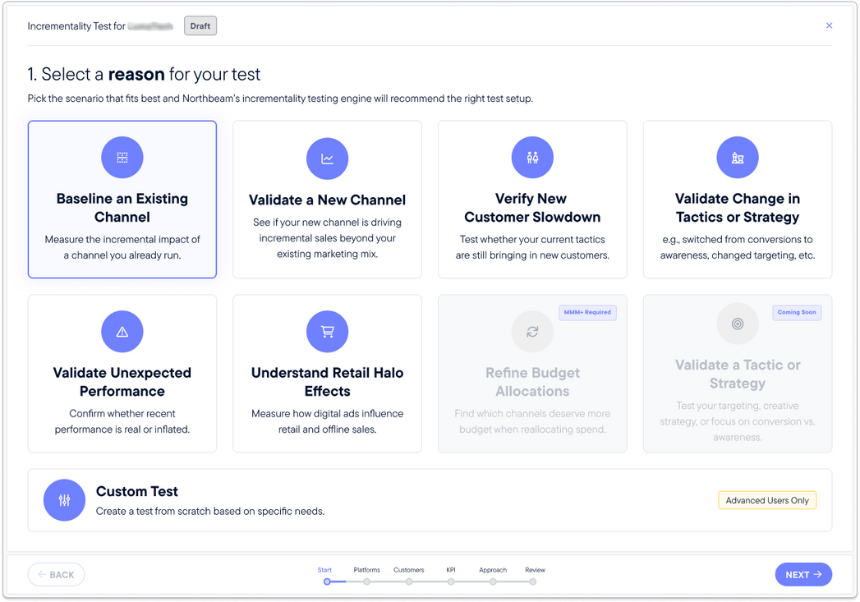
The outputs give you clear strategic action directly inside Northbeam, ensuring you can take your learnings and apply them alongside your MTA and MMM analyses.
It replaces vendor handoffs, ad‑hoc geo matching, manual pacing/cooldowns, and disconnected readouts that never make it back into daily optimization.
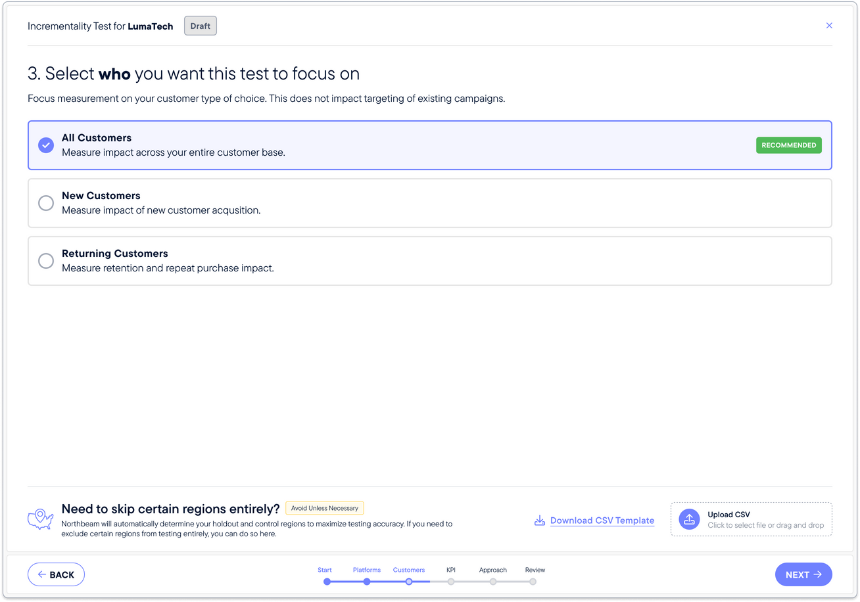
This is the future of incrementality: automated, accurate, and actionable.
Why Northbeam is different
We designed Incrementality by Northbeam to automatically solve for the major challenges marketers face when working with other incrementality vendors, agencies, or self-built tools.
Here’s what makes Northbeam’s incrementality different:
End‑to‑end automation. From design to platform setup, pacing, cooldowns, validation, and teardown, all inside Northbeam, no spreadsheets required. Just pick your goals and launch.
Bias control (geo + MTA depth). Region selection and balancing leverage conversion lag, Clicks + Deterministic Views, and behavioral patterns to reduce hidden bias versus geo‑only methods.
Continuous validation. The system keeps validating pre‑launch and daily, alerting you before drift undermines test integrity — it won’t let you run a bad test.
Unified measurement. Incrementality feeds back into MTA, MMM, and benchmarks, closing the loop between experimentation, attribution, and planning.
How to use incrementality
As part of your three-part marketing analytics toolbox, incrementality is best for understanding the high-level impact of a campaign or channel.
Validate new channels or tactics (e.g., a new Meta bid strategy) before scaling. Use the results of your lift tests to calibrate targets for the future.
Test if you should recalibrate ROAS/iROAS targets when you suspect diminishing returns. Set incrementality tests to re-evaluate even your most established channels and campaigns.
Diagnose performance fatigue and decide where to reallocate. Confirm whether a channel’s incremental value still justifies budget.
Quantify halo across Amazon/retail/offline so you don’t underfund demand creation that doesn’t show up fully in clicks-only reads.
Plan monthly budgets with confidence by reconciling lift with daily MTA and MMM to avoid analysis paralysis.
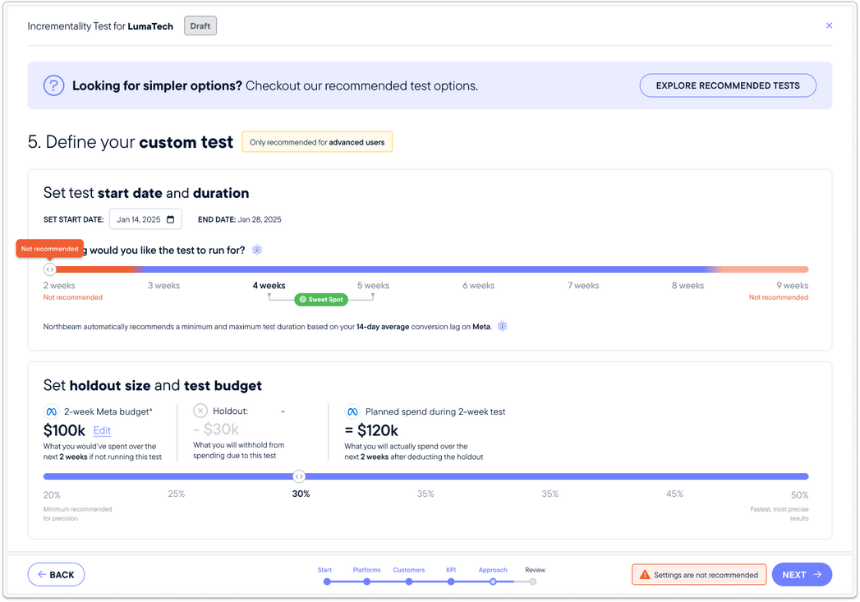
How it fits your stack
Because Incrementality lives inside Northbeam, incrementality becomes part of your day‑to‑day operating system.
Alongside C+DV‑enhanced MTA and MMM forecasts, incrementality’s causal truth can help inform both tactical day-to-day bidding and long‑term budget.
Since all three analyses are in the same tool, operating on the same data, you never have to worry about conflicting perspectives or challenges incorporating one analysis into another.
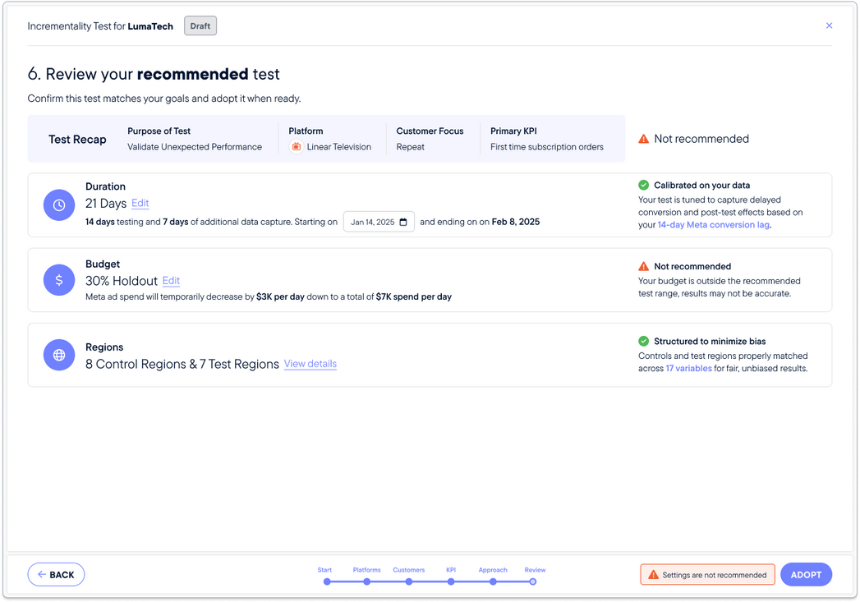
Get Incrementality today
Incrementality by Northbeam launches in Q1 2026. However, we’re putting together a cohort of founding members.
Request a demo here to chat with our team about incrementality.
We are offering founding member bonuses for a limited time. Advertisers who join now can lock in 50% off unlimited tests for an entire year.
Incrementality by Northbeam turns lift testing into an operational advantage: automated design and execution, rigorous validation, clear readouts, and a direct line into MTA and MMM so you can act daily on causal truth.
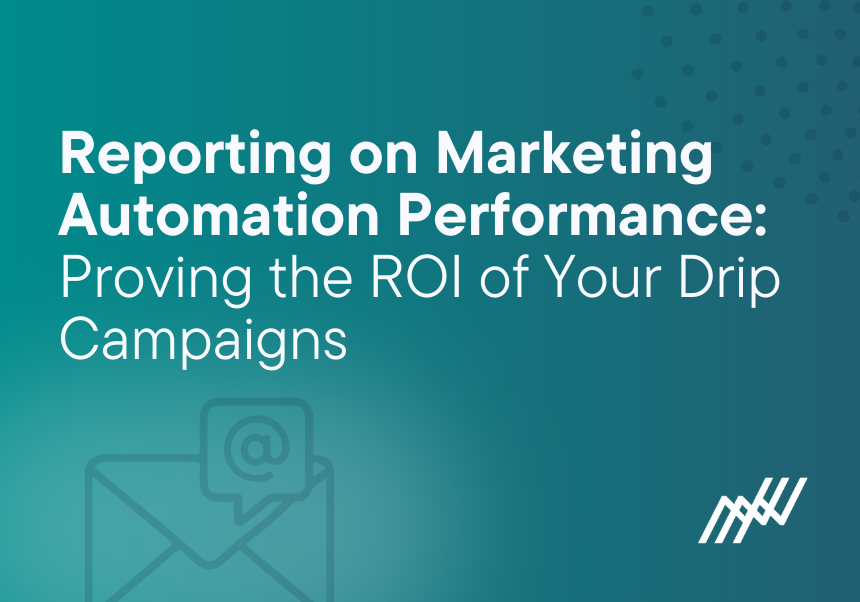
Reporting on Marketing Automation Performance: Proving the ROI of Your Drip Campaigns

Marketing automation is supposed to make everything easier: fewer manual emails, more consistent follow-ups, smoother nurture flows.
But once a drip campaign is launched, it often becomes a black box. Is it working? Which emails actually matter? Is it driving pipeline or just sending emails into the void?
Without clear reporting, you’re guessing. And guessing is expensive.
Modern growth teams need visibility, attribution, and proof, not just consistent activity. Reporting on your drip campaigns is the only way to know whether your automations are generating real business value.
This article walks through reporting on marketing automation performance and providing the ROI of drip email campaigns.
You’ll learn which metrics matter (engagement, conversion, revenue, attribution, efficiency), how to build a reporting framework and dashboard, how to connect drip activity to real conversions, and how to optimize sequences based on data.
You’ll also see a sample case study of how better reporting can improve conversion rates and ROI. By the end, you’ll have clear steps you can take to audit, measure, and improve your automated drip campaigns.
Why Reporting Matters for Drip Campaigns
Marketing automation is powerful. It saves time, scales your outreach, and ensures every lead gets the right message at the right moment.
But automation alone doesn’t guarantee impact. Without strong reporting, you have no way of knowing which sequences are actually moving people through the funnel and which ones are just running in the background.
Good marketing automation reporting turns drip campaigns from “set it and forget it” workflows into measurable growth levers.
A major reason reporting matters is attribution. Drip campaigns rarely operate in isolation; they touch the same users who are seeing ads, visiting your website, talking to sales, or signing up for demos.
If your reporting can’t connect drip activity to downstream conversions and revenue, you’ll never truly understand the incremental value your automations are generating.
Linking enrollment, engagement, and follow-through actions back to revenue outcomes is how you move from email metrics to business metrics.
There’s also a growing business expectation: stakeholders want proof of performance.
“We sent five emails” isn’t enough anymore. Leadership teams want to see which flows influence pipeline, shorten time-to-value, or reduce manual follow-up.
Yet research shows that only approximately 10% of marketers said they could effectively measure program impact. That’s the difference between teams who can defend their automation investment and teams who can’t.
Strong reporting closes that gap. It gives you visibility, attribution clarity, and credibility, the three ingredients that turn drip campaigns into provable ROI engines.
Defining the Reportable Metrics for Drip Campaigns
Before you can prove the impact of your drip campaigns, you need clarity on which metrics actually matter.
Strong reporting frameworks blend engagement, conversion, revenue, attribution, and efficiency indicators into a single view that shows not just what users did, but how that activity influenced the business.
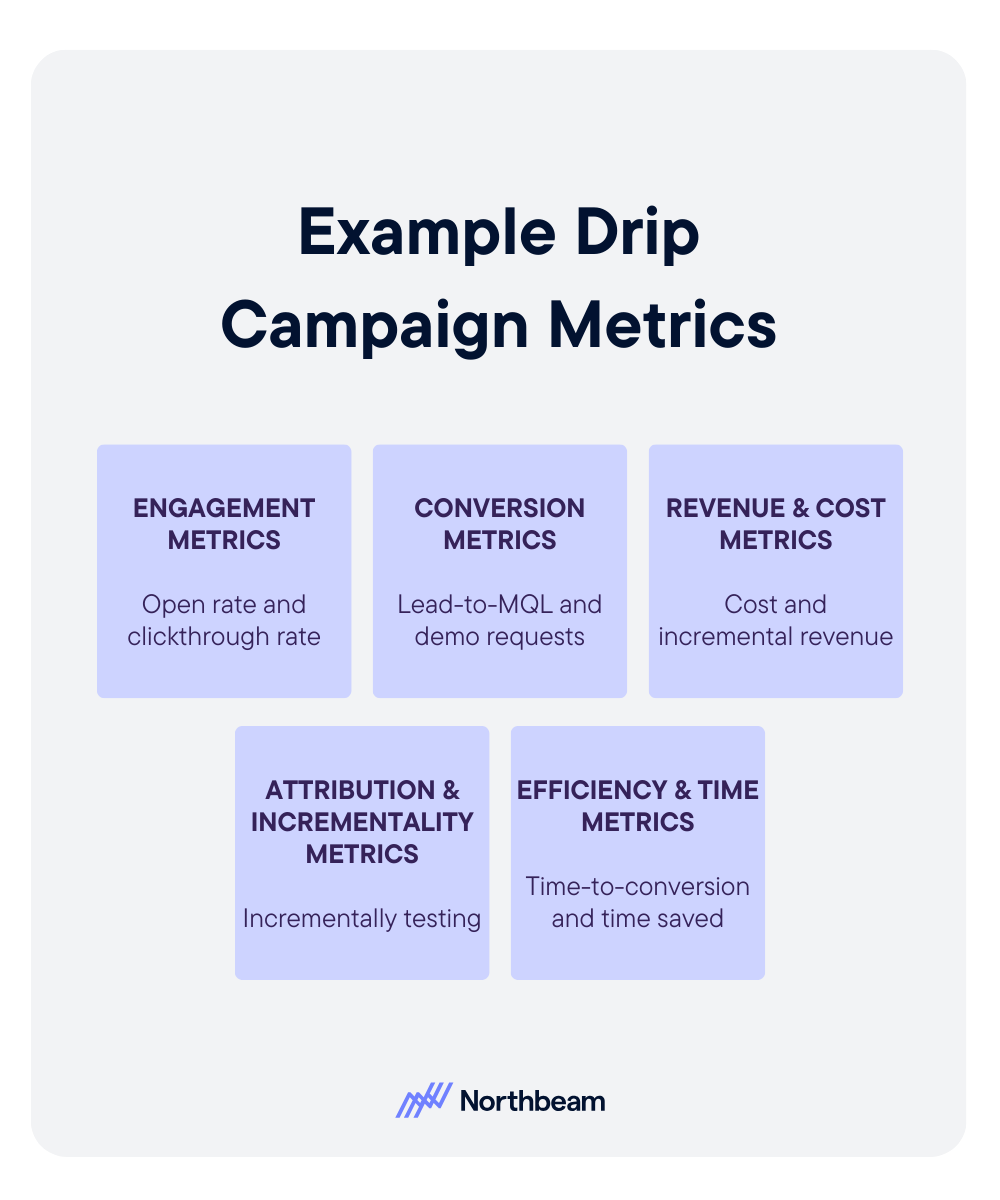
Engagement Metrics
Engagement metrics like open rate, click-through rate (CTR), and interactions with individual steps in the sequence help you understand whether the content resonates and where users fall off.
These metrics diagnose friction and message relevance, serving as early signals of sequence health.
Conversion Metrics
Conversion metrics translate engagement into outcomes: lead-to-MQL progression, MQL-to-SQL movement, demo requests, purchases, or any downstream action directly tied to the drip.
These metrics reveal whether the sequence actually influences pipeline, not just inbox behavior.
Revenue & Cost Metrics
To quantify ROI, you need a clear view of both sides of the equation: the cost of the campaign (platform spend, content creation, staffing) and the incremental revenue it generates.
Without these metrics, reporting risks overemphasizing activity rather than profitability.
Attribution & Incrementality Metrics
Drip campaigns sit inside complex, multi-touch customer journeys.
Drip campaign attribution and reporting best practices (supported by tracking parameters, unique identifiers, and closed-loop reporting) help isolate the drip’s actual contribution to conversions.
Incrementality testing (such as holdout groups) strengthens confidence that results didn’t happen by chance or via other channels.
Efficiency & Time Metrics
Efficiency metrics capture how automation improves operations. Think time-to-conversion, reductions in manual follow-ups, and the total scale of users enrolled in the sequence.
These metrics show the internal value of automation, not just the external performance.
Across all categories, the golden rule is this: your reporting must ultimately roll up to business outcomes.
CAC, LTV, and ROI are the numbers stakeholders care about. The more directly your metrics connect to these outcomes, the stronger your case for continued investment in marketing automation.
Building a Reporting Framework & Dashboard for Your Drip Campaigns
A strong reporting foundation turns your drip campaigns from opaque workflows into measurable, optimizable growth assets.

These are the core components your framework needs:
1. Map Campaign Flows and Touchpoints
Start by visualizing the full journey: where the drip sits in the funnel, what triggers entry, and which actions you expect users to take.
Clear mapping ensures your reporting aligns with the actual user path and helps you understand which moments matter most.
2. Set Up Attribution Linking
Connect drip enrollments to downstream behaviors like ad clicks, site visits, demo requests, and purchases.
Attribution depends on clean tracking (unique identifiers, synced platforms, structured tagging, etc.) so you can isolate the drip’s influence instead of losing it in the noise of multichannel activity.
3. Define Baseline and Control Groups
To measure true incrementality, build a control cohort that does not enter the sequence.
Comparing performance between exposed and unexposed groups allows you to attribute lift confidently, instead of guessing whether a conversion would have happened anyway.
4. Select Key Visualizations
Strong dashboards rely on visual clarity. Include funnel drop-off charts (enrollment → email 1 → email 2 → conversion), revenue-over-time by cohort, cost-versus-revenue curves, and efficiency indicators like time-to-conversion.
These visuals quickly show what’s working and where users fall away.
5. Automate Data Flows
Centralize data from your CRM, email automation platform, analytics tools, and attribution system.
Automated pipelines ensure your reporting stays timely, accurate, and consistent; no more manual CSV exports or out-of-date dashboards.
6. Build Stakeholder-Ready Reports
Finally, translate your metrics into insights. Stakeholder-facing reports should include segmented views (by audience, channel, or campaign), KPIs tied to business outcomes, and a simple narrative: what worked, why it worked, and what you’re doing next.
This is where reporting becomes operationally useful, not just informational.
Ensuring Drip Campaigns Deliver ROI & Attribution Clarity
To prove the value of your automated sequences, your drips need more than good content. They need to be engineered for measurable performance from the start.
That means clear triggers, thoughtful segmentation, consistent follow-ups, and reporting systems designed to track the full economic impact of every touch.
Make sure to follow these best practices:
Set Up Drip Campaigns With Performance in Mind
High-performing drips start with strong architecture. Define who enters the sequence, why they enter, and what actions you expect them to take.
Use segmentation to ensure the right users get the right message at the right time, and build timely follow-ups that encourage progression instead of passive engagement.
When the structure is intentional, the reporting becomes meaningful.
Attribute Conversions in Multi-Touch Journeys
In reality, users interact with ads, pages, emails, and sales outreach long before they convert, which means attribution rules matter.
Decide whether you’ll use first-touch, last-touch, linear, or weighted multi-touch models, and make sure your system recognizes drip events as legitimate touchpoints.
Proper tagging and consistent identifiers keep your drips from disappearing in attribution black holes.
Compare Cost vs. Benefit, Not Just Engagement
Opens and CTRs can make a campaign look successful, but they don’t prove ROI. What matters is the incremental revenue generated by the drip compared to the cost of building, running, and maintaining it.
Calculating ROI forces you to evaluate whether the sequence is an essential growth engine or simply an automated expense.
Build Continuous Optimization Loops
Strong reporting isn’t static, it’s a feedback system. Use your dashboard to identify where users drop off, which segments underperform, and which emails fail to convert.
Then iterate: adjust content, tweak timing, refine targeting, or split test your highest-friction steps. Continuous optimization keeps the drip aligned with user behavior and business goals.
Account for Cross-Channel Interactions
Drip campaigns rarely operate alone. A user might click an ad, join a drip, revisit your site, and schedule a demo all within the same journey.
Your reporting should reflect this reality. Map how paid media, website activity, and lifecycle messaging interact, and ensure your attribution model credits the drip for the role it plays in driving users toward conversion, not just the final click.
Challenges & Pitfalls in Reporting Drip Campaign Performance
Even the most sophisticated automation programs run into obstacles when it comes to capturing accurate, actionable performance data.
Here are some of the most common challenges teams face and why they matter:
Data Silos and Disconnected Systems
Your email platform, CRM, analytics tools, and attribution software don’t always communicate cleanly. When data sits in separate systems, it becomes difficult to stitch together a full-funnel view of how users move from drip engagement to conversion.
This disconnect often leads to incomplete reporting or misleading conclusions.
Attribution Complexity
Drip campaigns rarely operate in isolation. Isolating the incremental value of a drip campaign in this multichannel environment is inherently tricky, especially without clear attribution rules and consistent identifiers.
Difficulty Measuring Long-Tail or Indirect Impact
Not every drip exists to drive an immediate purchase. Some sequences influence retention, expansion, onboarding success, or long-term product adoption.
These outcomes can be harder to quantify, and they don’t always map neatly to traditional ROI formulas, which creates a risk of undervaluing high-impact lifecycle flows.
Over-Focus on Soft Metrics
Open rates and click-through rates can provide useful directional insights, but they don’t prove business impact. Teams that rely too heavily on soft metrics risk optimizing emails instead of optimizing revenue.
Manual Reporting and Stale Data
When reporting requires manual exports, spreadsheet cleanup, or piecing together metrics from multiple tools, insights arrive too slowly to guide real optimization.
Delayed or inconsistent data means missed opportunities to fix drop-offs, refine segmentation, or improve timing.
Implementation Cost vs. Perceived Value
Robust reporting requires tracking, integrations, and aligned data structures, all of which take time and resources. Teams may hesitate to invest in this infrastructure unless the value is clear.
Without adequate setup, though, automation programs often underperform simply because their impact isn’t visible.
Example Case Study: B2B SaaS Company
To illustrate how effective reporting transforms drip campaigns, let’s look at a sample scenario from a B2B SaaS company running a 14-day product trial.
The team built a welcome-drip sequence triggered at signup: a five-email flow designed to guide new users toward activation milestones and, ultimately, a demo request.
Once the sequence had been live for a few weeks, the reporting dashboard surfaced a clear issue: a steep drop-off between enrollment and the second email.
Most users opened the first message but ignored the follow-ups, which meant they weren’t progressing toward activation.
By layering in segmentation (separating enterprise prospects from smaller teams), and adjusting the timing of the second and third emails, the team was able to deliver more relevant content to each group at the right time.
Attribution also played a critical role here. By tagging every email interaction with a unique user ID and syncing activity into the CRM, the team connected drip engagement to downstream actions like demo requests and closed deals.
A multi-touch attribution model clarified the drip’s role in the broader journey, showing that users who completed at least three emails converted at a meaningfully higher rate.
The impact of this tightening-up process was immediate. After the segmentation and timing updates, the conversion rate from trial to demo increased by 30 percent among users who entered the drip.
The improved sequence also delivered stronger economics: the campaign’s cost-to-revenue ratio improved by 25 percent once optimization efforts kicked in.
A glance at the reporting dashboard told the story visually. Funnel drop-off charts revealed where attention declined. A cost-versus-revenue graph illustrated the financial lift over time. A heatmap of segment performance showed which audiences responded best, helping the team prioritize future improvements.
This example shows how a well-instrumented drip campaign becomes a measurable growth lever, and how the right reporting framework can surface the insights needed to unlock real ROI.
Actionable Next Steps for Your Team
Once you’ve built a clear reporting foundation, the final step is putting it into practice.
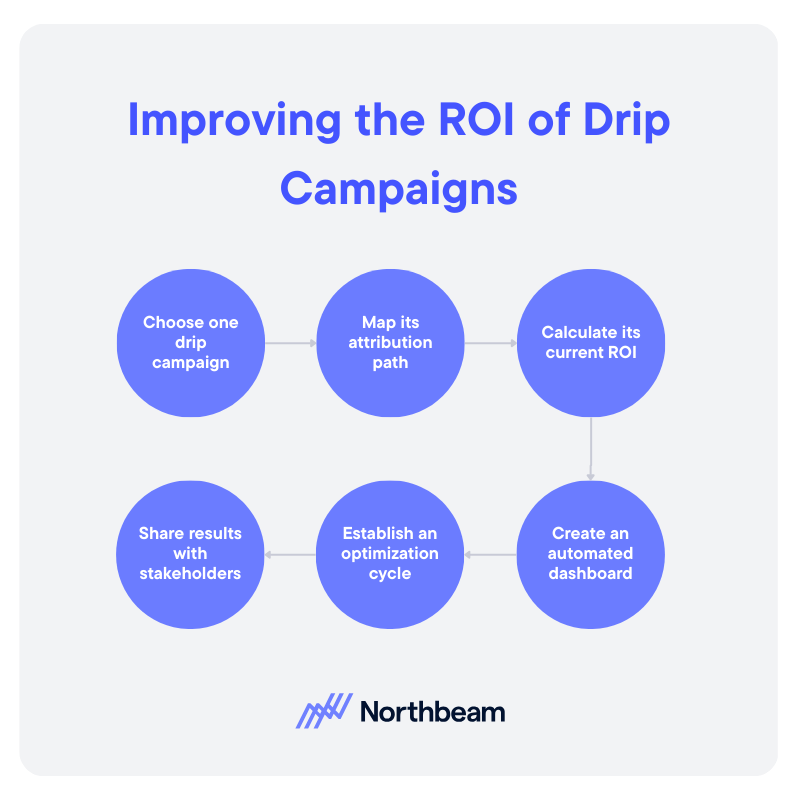
This checklist can help you operationalize your insights, improve drip campaign performance metrics quickly, and make drip campaigns a measurable contributor to growth:
- Audit your current drip reporting setup: List every active sequence, its data sources, the metrics you track today, how attribution works, and whether you have an up-to-date dashboard.
- Choose one drip to improve and map its attribution path: Ensure you can connect enrollment → engagement → action → revenue in your analytics or attribution system. If any link in that chain is missing, fix it.
- Calculate ROI for at least one existing campaign: Define the campaign’s full cost (platform, content, staffing), measure its incremental revenue, and compute ROI using (Revenue – Cost) / Cost. This becomes your baseline.
- Create or refine a fully automated dashboard: Set it to update without manual intervention and surface the essentials: enrollments, drop-offs, conversions, revenue, ROI, and segment-level differences.
- Establish a recurring optimization cycle: Add a weekly or bi-weekly review to evaluate performance, identify drop-offs, run experiments, and continuously refine content, timing, and segmentation.
- Share results with stakeholders in a business-focused format: Highlight pipeline influence, revenue lift, and efficiency gains, not just email engagement. Keep the narrative concise and tied directly to business impact.
Bringing It All Together
Strong drip campaigns need to perform, and the only way to prove that performance is through clear, consistent reporting.
When you track the right metrics, build attribution into your workflows, and use dashboards to surface what’s actually driving conversions, your automations become powerful and measurable rather than background noise.
By investing in thoughtful reporting now, you give your team the clarity to optimize confidently, the credibility to demonstrate ROI, and the insight to scale what works.
If you haven’t audited your automations in a while, now is the perfect time to start.

Marketing Funnel Automation: Scaling Engagement on Autopilot

Marketing funnels are more complex than ever, and manual workflows can’t always keep up with how people move between channels and touchpoints.
Automation offers a way to guide prospects through the journey with consistent, timely interactions while generating the structured data you need to measure what works and scale efficiently.
This guide walks through how to automate your marketing funnel for scale in order to give you a practical framework you can use immediately, whether you’re building a new automated funnel or improving one already in place.
Why Automate Your Marketing Funnel & What It Enables
Marketing funnel automation strategy involves using tools and workflows to move prospects from awareness to retention with as little manual work as possible while still giving each person a personalized experience.
The core benefit is efficiency. An automated marketing funnel supports growing demand without requiring your team to scale at the same pace.
It handles repetitive tasks, routes leads based on rules, and delivers nurture messages automatically. That frees your team to focus on strategy, testing, and high value interactions.
Automation also brings consistency and faster response times. When workflows trigger based on behavior, there is no lag between a prospect taking an action and your system responding. The result is a smoother customer experience and fewer missed opportunities.
Finally, automated engagement funnels for paid media and attribution also improve tracking and clarity. Automated funnels generate reliable, structured touchpoints that feed into your measurement stack. Every form submit, nurture step, retargeting trigger, and workflow event is captured and tied to downstream conversions.
For teams using attribution or multi touch modeling, this level of completeness matters. It provides a more accurate picture of how users move through the funnel, what actually influences conversion, and where to invest next.
Mapping the Funnel & Identifying Automation Opportunities
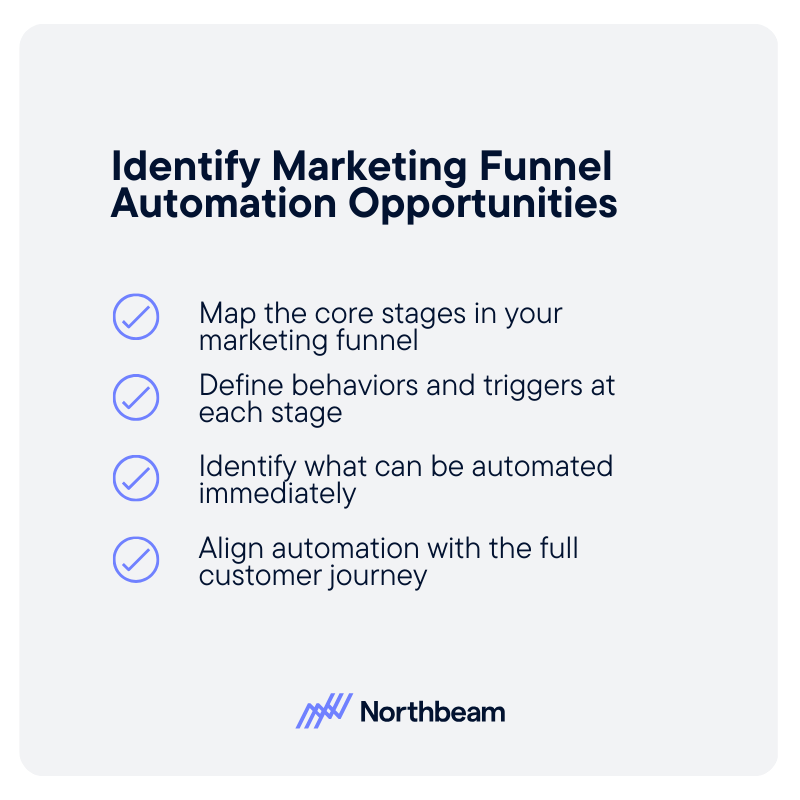
A well-automated funnel starts with a clear understanding of how people move from first touch to long-term engagement.
Map Your Core Funnel Stages
Start by outlining the major steps in your marketing journey. A common structure might be: Paid Ad, Lead Capture, Nurture Sequence, Conversion, and Retention.
Define Behaviors and Triggers at Each Stage
Identify which meaningful actions happen within each stage. Examples include ad clicks, form submissions, content downloads, email opens, and product page views.
Add entry and exit criteria so you know when someone has truly progressed. Micro conversions like scroll depth or repeat visits help you understand intent.
Identify What Can Be Automated Immediately
Pinpoint the workflows that can run without human involvement. For example:
- Lead capture and qualification rules can send new contacts straight to your CRM
- Nurture sequences can trigger based on behavior and deliver timely email, in-app, or retargeting messages
- Cross-channel retargeting can reflect real funnel movement or drop off patterns.
Identify Where Humans Still Add Value
Not every step benefits from automation. High intent demos, complex outreach, or sales conversations require context and judgment. Mark these moments clearly so automation supports your team rather than replaces essential human touch.
Align Automation to the Full Customer Journey
Once stages, triggers, and responsibilities are in place, ensure your systems pass users smoothly from one step to the next.
Automated actions should set up human interactions, and human interactions should feed back into automated tracking. This keeps your funnel coherent, measurable, and ready for scale.
Building the Automation Workflow & Measurement Plan
Once your funnel stages are clear, the next step is building an automation system that responds to real user behavior and produces reliable, measurable data.
Choose the Right Tools and Integrations
Start by selecting the platforms that will power your automated funnel. Most teams rely on a marketing automation platform, CRM, ad platforms, analytics tools, and an attribution system.
Design Clear Workflow Logic
Define the rules that determine how users move through your automation:
- Set behavior triggers like page visits, ad clicks, or content downloads
- Add segmentation and branching rules that adjust messages based on source, engagement, or lead value
- Map out automated messaging and retargeting sequences
- Establish lead scoring thresholds so high intent users can be handed to sales at the right moment
Instrument Your Funnel Events
List the key events that matter for both automation and attribution. This usually includes impressions, clicks, form submits, nurture engagements, and conversions. Ensure each event is captured in a consistent, structured way so it can power both your workflows and your reporting.
Align Automation with Your Attribution Model
Connect each workflow step to your attribution system. This allows you to trace a user from their first touch through the automated journey and view the full impact of your funnel on pipeline and revenue.
Build Dashboards for Visibility
Create dashboards that highlight funnel flow, drop off points, workflow engagement, lead progression, conversion rates, and ROAS. These help you monitor performance at a glance.
Plan for Continuous Optimization
Schedule regular reviews to identify bottlenecks, test timing or sequencing changes, and compare variations of nurture content. Your automation should evolve based on data, not remain static.
Scaling Engagement With Marketing Funnel Automation Without Losing Personalization
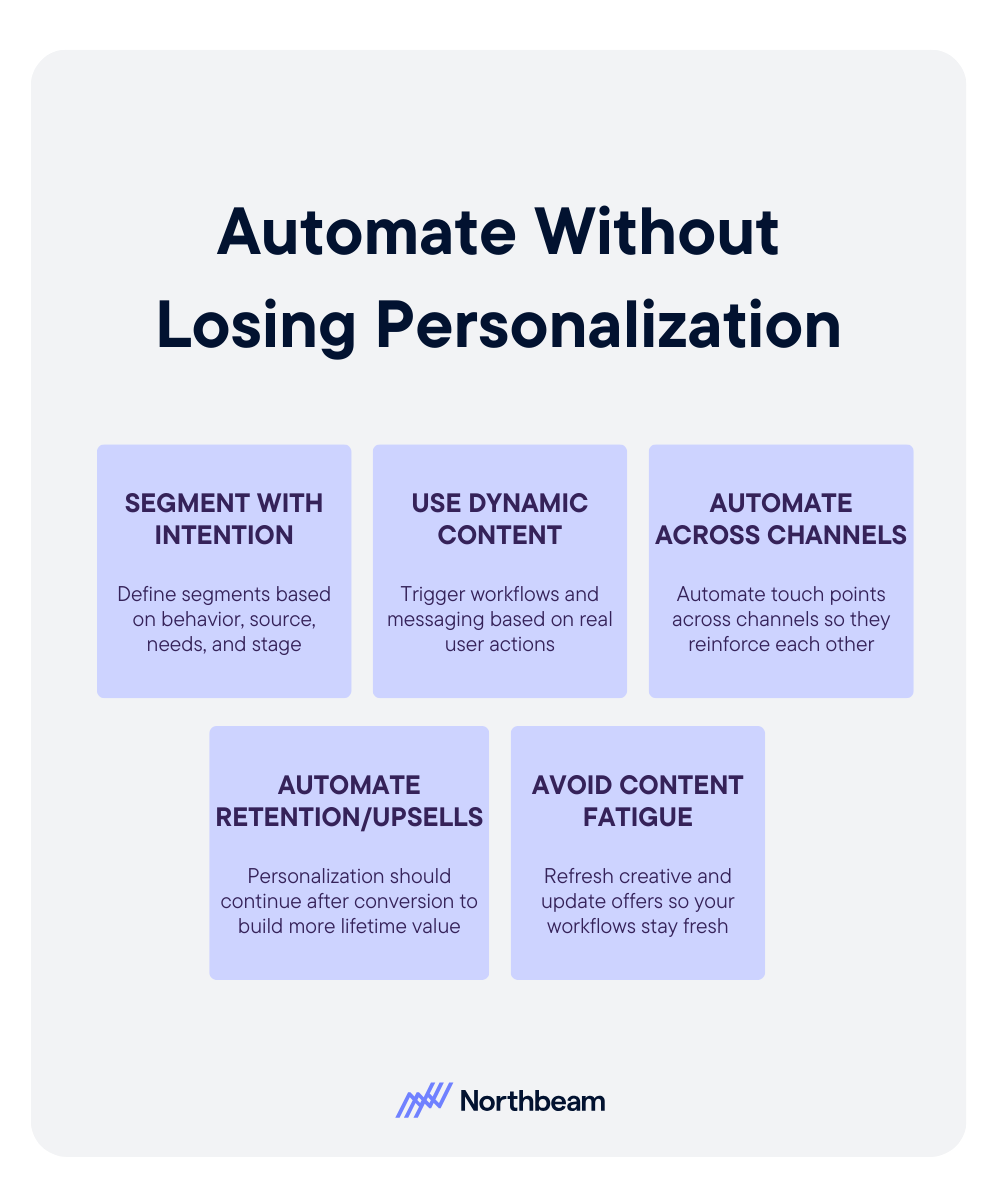
Here’s how to expand your reach without sacrificing the personal touch that moves users through the funnel.
Segment Your Audience With Intention
Start by defining meaningful segments based on behavior, source, needs, or lifecycle stage. Tailor each workflow to the user’s context so they receive messages that reflect what they care about, not a generic sequence.
Use Behavior-Based Triggers and Dynamic Content
Trigger workflows based on real actions like repeat visits, content engagement, or product exploration. Dynamic content lets you adjust messaging automatically, showing different offers or creative to users based on their past behavior.
Orchestrate Cross Channel Automation
Automate touchpoints across ads, email, in app interactions, and SMS so that each channel reinforces the others rather than competing.
When a user downloads a guide, for example, they might receive a follow up email, and see aligned retargeting ads. The experience should feel coordinated, not chaotic.
Automate Retention and Upsell Flows
Personalization should continue after conversion. Build sequences for onboarding, loyalty rewards, engagement automation, and upsell opportunities. These workflows help you extract more lifetime value and keep users active.
Monitor and Refresh Content to Avoid Fatigue
At scale, even strong sequences can start to lose impact. Watch for falling open rates, rising unsubscribes, or declining conversion rates. Refresh creative, rotate offers, and update triggers regularly so your automated funnel stays relevant.
Attribution & Performance Monitoring in an Automated Funnel Context
Automation adds scale and consistency to your funnel, but it also creates more touchpoints that must be tracked accurately.
Strong performance monitoring ensures you know which automated steps are driving real results, not just activity.
Capture Every Automated Interaction
Make sure your attribution system records all relevant events, including automated nurtures, retargeting impressions, message sends, and workflow steps.
Define Micro Conversions and Link Them to Outcomes
Identify the moments that signal meaningful progression, such as completing a nurture step, clicking a key CTA, or returning to your site.
Map these micro conversions to downstream outcomes like trial starts, demo requests, or purchases. This helps you understand not just who converts, but how they convert.
Use Holdouts to Prove Incremental Lift
Automation can create correlation without real causal impact. Introduce holdout or control groups that do not receive a specific workflow or message. Compare performance to determine whether your automation is truly adding lift or simply engaging users who would have converted anyway.
Measure Incremental ROAS Across the Funnel
Track improvements in cost per lead, conversion rate, and time to conversion for users who move through automated flows. Tie these gains to spend and revenue so you can quantify how automation affects return on ad spend and overall pipeline efficiency.
Monitor for Anomalies or Workflow Misalignment
High engagement but low conversion often signals an issue. You may have an ineffective message, a confusing branching path, or a retargeting loop that keeps users stuck.
Build automated reporting that flags these anomalies early so you can adjust before your funnel performance suffers.
Common Pitfalls & Automation Risks
Automation can accelerate your funnel, but it also introduces new risks.
Being aware of common pitfalls helps you build systems that scale cleanly rather than create more problems to solve:
Avoid Irrelevant or Poorly Segmented Flows
Automation only works when it speaks to the right people. Broad or mismatched segments lead to low engagement, higher drop offs, and unsubscribes.
Review your logic regularly to ensure each workflow matches user intent and lifecycle stage.
Balance Automation With Human Context
Too much automation can feel cold or scripted. Prospects will notice if every message feels templated.
Identify the moments where human judgment matters, such as high intent outreach or complex questions, and ensure workflows hand off gracefully to real people.
Connect Automation to Your Attribution Stack
If automated events are not tracked, you lose visibility into what actually drives conversions. This turns optimization into guesswork.
Make sure every workflow step is captured as a touchpoint so your attribution model can reflect the real user journey.
Break Down Data and System Silos
Disconnected tools create blind spots in your funnel. When your CRM, automation platform, analytics tools, and ad channels don’t share data, you can’t see where users are progressing or getting stuck. Integrations keep your workflows cohesive and your reporting accurate.
Monitor Scale Before Problems Grow
As you scale traffic and automation, small misalignments can become expensive quickly. Watch for rising CPL, stagnant conversion rates, or sudden drop offs that signal bottlenecks.
Refresh Content to Prevent Fatigue
Automated sequences lose effectiveness over time. Declining open rates or engagement indicate that messaging has gone stale.
Update creative, rotate offers, and adjust timing to keep your funnel feeling fresh and relevant.
Case Study: How a DTC Brand Scaled Engagement With An Automated Funnel
A DTC brand wanted to improve conversions from its paid social campaigns without adding more manual work.
They promoted a free downloadable guide as their main acquisition offer, and every download fed into a new automated workflow that combined a short email sequence, targeted retargeting, and a limited time purchase incentive.
Each step in the journey was tracked as a structured event. This gave the team a clear view into how users moved through the funnel and which touchpoints actually influenced conversions.
Leads who entered the automated workflow converted at twice the rate of standard leads and cost 30 percent less to acquire, since nurtures and retargeting were triggered based on real behavior.
Because workflow events were synced with their attribution model, the team could see which ad channels delivered the most engaged leads.
They reallocated budget toward audiences that consistently fed high quality traffic into the workflow and improved ROAS without increasing spend.
As volume grew, they expanded the automation into a simple multi-channel sequence using ads, email, and SMS.
The larger dataset revealed a bottleneck in the nurture journey, where many users dropped off around the third email. After testing new timing and creative, they recovered a meaningful share of those lost conversions.
The combination of personalized automation and attribution visibility gave the brand a scalable, measurable path to growth, and a framework they could continue improving as they expanded.
Actionable Next Steps for Your Team

If you want to build a funnel that scales consistently and improves over time, start with a few high-impact steps:
1. Map Your Current Funnel
- Outline each stage and the key behaviors within it.
- Mark where automation already exists.
- Identify manual gaps that create delays or inconsistent follow up.
2. Improve One Funnel Segment First
- Choose a narrow portion of the journey, such as lead capture to nurture.
- Define its behavior triggers, messaging sequences, and exit criteria.
- Clarify the metrics that matter so you can measure progress.
3. Connect the Workflow to Your Attribution Stack
- Ensure every automated event (form submit, nurture step, retargeting trigger) is recorded as a touchpoint.
- Create a dashboard that shows workflow engagement, drop offs, conversion rates, and ROAS.
4. Expand Automation Across Channels
- Add coordinated touchpoints across ads, email, in app channels, and SMS.
- Make sure users experience a consistent journey even when switching devices or platforms.
- Track how each channel contributes to movement through the funnel.
5. Set a Regular Review Cadence
- Review automation performance monthly.
- Refresh creative, adjust timing, and test new variations.
- Scale what works and retire what does not.
6. Share Results With Stakeholders
- Communicate outcomes in business terms, not just engagement metrics.
- Highlight conversion improvements, cost per acquisition changes, and overall funnel velocity.
By improving one part of the funnel at a time and aligning automation with your attribution model, you create a system that gets smarter with every cycle.

Follow us














.svg)
